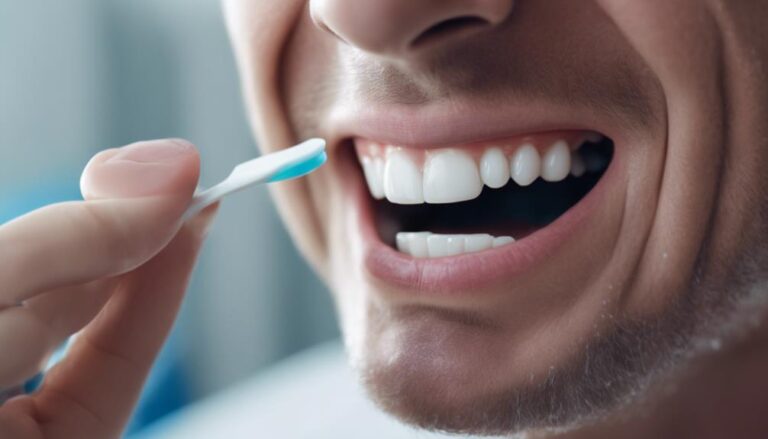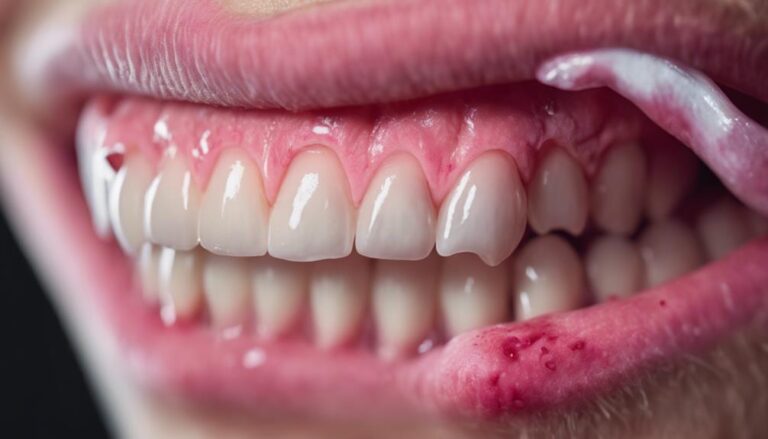To combat halitosis and gum disease effectively, I recommend a holistic approach. Start with lifestyle changes like stress management and a balanced diet. Follow proper oral hygiene, including gentle and regular brushing, flossing, and replacing your toothbrush regularly. Regular dental cleanings and visits are important for early detection. Consider using antibacterial mouthwash and consult a dentist for suitable options. Professional procedures like scaling and root planing are essential. Don’t forget tongue scraping, dietary adjustments, and be aware of cost considerations for surgeries if needed. Each step plays an important role in maintaining excellent oral health and freshness.
Key Takeaways
- Regular dental cleanings to remove plaque and prevent gum disease.
- Antibacterial mouthwash to target harmful bacteria causing bad breath.
- Incorporate tongue scraping to remove bacteria and improve breath.
- Consider scaling and root planing for deep cleaning and gum disease treatment.
- Maintain proper oral hygiene with brushing, flossing, and dental visits.
Lifestyle Changes
To effectively address halitosis and gum disease, making key lifestyle changes is essential. Stress management plays an important role in oral health as heightened stress levels can lead to an increase in gum disease severity. Incorporating stress-relief techniques such as mindfulness meditation or yoga into daily routines can help alleviate stress and improve overall oral health.
Additionally, diet modifications can have a major impact on halitosis and gum disease. Consuming a diet high in sugary and acidic foods can contribute to bacterial growth in the mouth, leading to bad breath and gum inflammation. Opting for a balanced diet rich in fruits, vegetables, and lean proteins can promote healthier gums and fresher breath.
Exercise routines can also benefit oral health by improving circulation and reducing inflammation in the body, which can positively impact gum disease. Regular physical activity, such as brisk walking or jogging, can help maintain healthy gums.
Moreover, adequate sleep patterns are essential for overall health, including oral health. Poor sleep quality has been linked to increased inflammation in the body, which can exacerbate gum disease. Establishing a consistent sleep schedule and practicing good sleep hygiene can support gum health and combat halitosis.
Proper Oral Hygiene
Maintaining proper oral hygiene is fundamental in preventing and managing halitosis and gum disease. When it comes to brushing technique, it’s important to use a soft-bristled brush and gentle, circular motions to clean all tooth surfaces effectively. Make sure to brush for a minimum of two minutes, twice a day, paying close attention to the gum line where plaque tends to accumulate. Additionally, replacing your toothbrush every three to four months or sooner if the bristles are frayed is necessary for effective cleaning.
Incorporating flossing into your daily routine is equally important. To floss effectively, use a piece of floss about 18 inches long, wrapping it around your fingers and sliding it between teeth in a gentle back-and-forth motion. Be sure to curve the floss around each tooth in a ‘C’ shape to reach below the gum line where plaque hides.
Regular Dental Cleanings
Regular dental cleanings are crucial for maintaining oral health and preventing issues such as halitosis and gum disease. These cleanings remove plaque and tartar buildup that brushing and flossing may not address. Dental hygienists can offer insights into proper flossing techniques and prevention strategies during these visits.
Regular dental visits also provide opportunities for dentists to assess oral health status. They can evaluate brushing frequency and techniques to offer guidance on cavity prevention. Early detection of problems like gum disease or decay is essential for timely intervention and prevention of more severe issues.
Antibacterial Mouthwash
During dental cleanings, the use of antibacterial mouthwash can further enhance oral hygiene by targeting harmful bacteria that contribute to halitosis and gum disease. Antibacterial mouthwashes are formulated to reduce bacteria in the mouth, which can help in preventing bad breath and gingivitis. These mouthwashes contain active ingredients such as chlorhexidine, cetylpyridinium chloride, and essential oils like eucalyptol, thymol, and menthol.
While they’re effective in reducing bacteria, overuse can lead to bacterial resistance, limiting their best long-term efficacy. It’s essential to follow the instructions provided by the manufacturer or dental professional when using antibacterial mouthwash to avoid potential side effects such as staining of teeth, altered taste sensation, or irritation of the oral tissues.
Consulting with a dentist can help determine the most suitable antibacterial mouthwash for individual needs, ensuring excellent oral health benefits while minimizing any risks associated with prolonged use.
Professional Scaling and Root Planing
Wondering how deep cleaning can benefit your oral health? Professional scaling and root planing, commonly known as a deep cleaning, is an important periodontal treatment for individuals with gum disease. This procedure is performed by dental professionals to remove plaque and tartar from below the gumline, where regular brushing and flossing can’t reach.
Deep cleaning is essential in treating gum disease because it helps eliminate bacteria and toxins that cause inflammation and infection. During scaling, the dentist or dental hygienist uses specialized tools to scrape away the buildup of plaque and tartar on the teeth and root surfaces. Root planing, on the other hand, involves smoothing out rough areas on the roots to prevent bacteria from reattaching.
Antibiotics
To complement professional scaling and root planing in the treatment of gum disease, antibiotics may be prescribed by dental professionals to target and eliminate any remaining bacteria causing inflammation and infection. Antibiotics are effective in reducing bacterial load, aiding in the resolution of gum disease. However, overuse can lead to bacterial resistance, diminishing their long-term efficacy. It is important to follow the prescribed treatment duration to prevent this issue.
| Antibiotic Type | Side Effects |
|---|---|
| Tetracyclines | Tooth discoloration |
| Penicillins | Allergic reactions |
| Macrolides | Gastrointestinal issues |
| Clindamycin | C. difficile infection |
| Metronidazole | Metallic taste |
When considering antibiotics, it is essential to weigh their potential side effects against the benefits they offer. Monitoring for any adverse reactions during treatment is significant. Dental professionals will determine the most suitable antibiotic based on the specific case, considering factors such as the patient’s medical history and the type of bacteria present.
Laser Therapy
Laser therapy is a minimally invasive treatment option for gum disease that targets and eliminates bacteria and infected tissue using focused light energy. Recent laser technology advancements have greatly improved the precision and efficiency of this treatment, enhancing patient comfort and reducing recovery times.
The benefits of laser therapy for gum disease are significant. The focused light energy can selectively remove infected tissue while leaving healthy tissue untouched, promoting quicker healing and reducing the risk of complications. Additionally, the heat from the laser helps to sterilize the treated area, further aiding in the elimination of bacteria.
Studies have shown laser therapy to be highly effective in treating gum disease, with comparable outcomes to traditional surgical methods. Patients undergoing laser therapy often experience less pain and swelling during and after the procedure, making it a preferred option for those seeking a more comfortable treatment experience. Laser therapy represents a cutting-edge approach to addressing gum disease, offering a combination of precision, effectiveness, and patient satisfaction.
Gum Graft Surgery
Exploring another effective treatment option for gum disease, Gum Graft Surgery is a surgical procedure aimed at restoring gum tissue lost due to recession or disease. During the surgery, tissue is taken from the roof of the mouth or a tissue bank and attached to the areas where gum recession has occurred, helping to cover exposed tooth roots and improve the overall health of the gums.
The recovery process after gum graft surgery can vary depending on the individual’s healing ability and the extent of the procedure. Typically, patients may experience some discomfort, swelling, and minor bleeding following the surgery. It’s important to follow post-operative care instructions provided by the dental professional to promote proper healing and reduce the risk of complications.
When considering gum graft surgery, it’s essential to discuss the cost comparison with your dental provider. The cost can vary based on the type of graft used, the extent of the procedure, and your insurance coverage. Understanding the financial aspect of the surgery can help you make an informed decision regarding your gum disease treatment.
Tongue Scraping
How can tongue scraping help improve oral hygiene and combat bad breath effectively? Tongue scraping is a simple yet effective practice that can be incorporated into your daily oral hygiene routine. By gently scraping the surface of the tongue, you can remove bacteria, food debris, and dead cells that contribute to bad breath and poor oral health. This Ayurvedic remedy has been used for centuries as part of holistic oral care.
When considering tongue scraping, it’s essential to understand its benefits and proper technique. Here is a table summarizing key points:
| Benefits of Tongue Scraping | Proper Technique | Ayurvedic Remedies | DIY Techniques |
|---|---|---|---|
| Removes bacteria and toxins | Use a tongue scraper | Oil pulling with coconut oil | Homemade mouthwash with essential oils |
| Improves bad breath | Scrape from back to front | Herbal mouth rinses | Tongue scraping with a spoon |
| Enhances taste sensation | Rinse scraper after each use | Neem sticks | Hydration and balanced diet |
Incorporating tongue scraping into your daily oral care routine can complement traditional brushing and flossing, offering natural solutions for fresher breath and improved oral health.
Dietary Adjustments
Making strategic dietary adjustments can play a significant role in promoting oral health and preventing common issues like halitosis and gum disease. When it comes to maintaining a healthy mouth, what you eat matters. Here are some key dietary adjustments that can help improve oral health:
- Nutritional supplements: Incorporating essential nutrients like vitamin C, vitamin D, and calcium through supplements can support gum health and overall oral well-being.
- Sugar reduction: Cutting down on sugary foods and beverages can help prevent the growth of harmful bacteria in the mouth, reducing the risk of cavities and gum disease.
- Hydration: Drinking an adequate amount of water throughout the day can help wash away food particles and bacteria that can contribute to bad breath and gum problems.
Frequently Asked Questions
Can Stress and Anxiety Worsen Halitosis and Gum Disease?
Stress and anxiety can exacerbate halitosis and gum disease. Lifestyle choices play an important role in oral health. Mental health impacts are vital considerations. Managing stress through relaxation techniques and maintaining good oral hygiene can help prevent worsening conditions.
Are There Any Alternative Remedies for Halitosis and Gum Disease?
When exploring alternative remedies for halitosis and gum disease, incorporating herbal remedies like tea tree oil and peppermint can help. Dietary changes, such as increasing water intake and consuming probiotics, may also improve oral health.
What Role Does Genetics Play in Halitosis and Gum Disease?
Genetics impact the likelihood of developing halitosis and gum disease. Understanding one’s genetic predisposition can help identify underlying causes early. For example, a family history of gum disease can prompt proactive dental care.
Can Hormonal Changes Affect Halitosis and Gum Disease?
Hormonal fluctuations can impact oral health, potentially affecting gum disease and halitosis. I prioritize consistent dental hygiene routines to mitigate these risks. Regular brushing, flossing, and dental check-ups help me maintain peak oral health despite hormonal changes.
Is There a Link Between Halitosis, Gum Disease, and Certain Medications?
Personally, pondering the potential link between halitosis, gum disease, and medications is intriguing. Medication effects vary; understanding these helps tailor prevention strategies. Diligent dental care complements managing any drug-related oral health issues effectively.
Conclusion
Overall, maintaining good oral hygiene and seeking professional dental care are key in treating halitosis and gum disease.
Did you know that up to 50% of adults over the age of 30 suffer from gum disease?
By following the recommended treatments and making necessary lifestyle changes, you can improve your oral health and prevent further complications.
Remember, prevention is always better than cure when it comes to dental issues.






